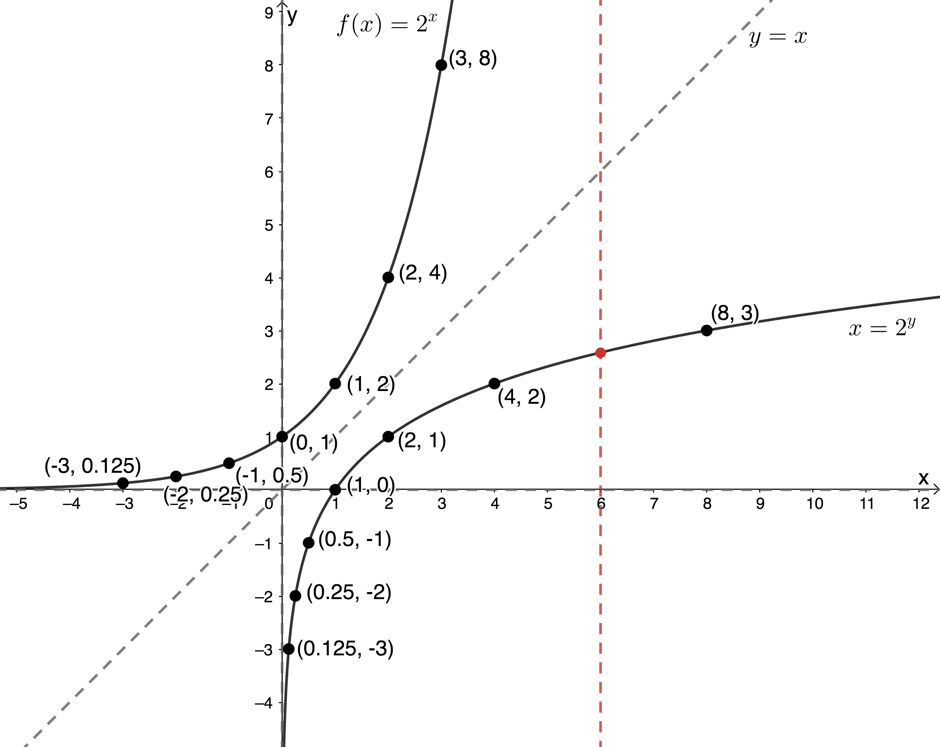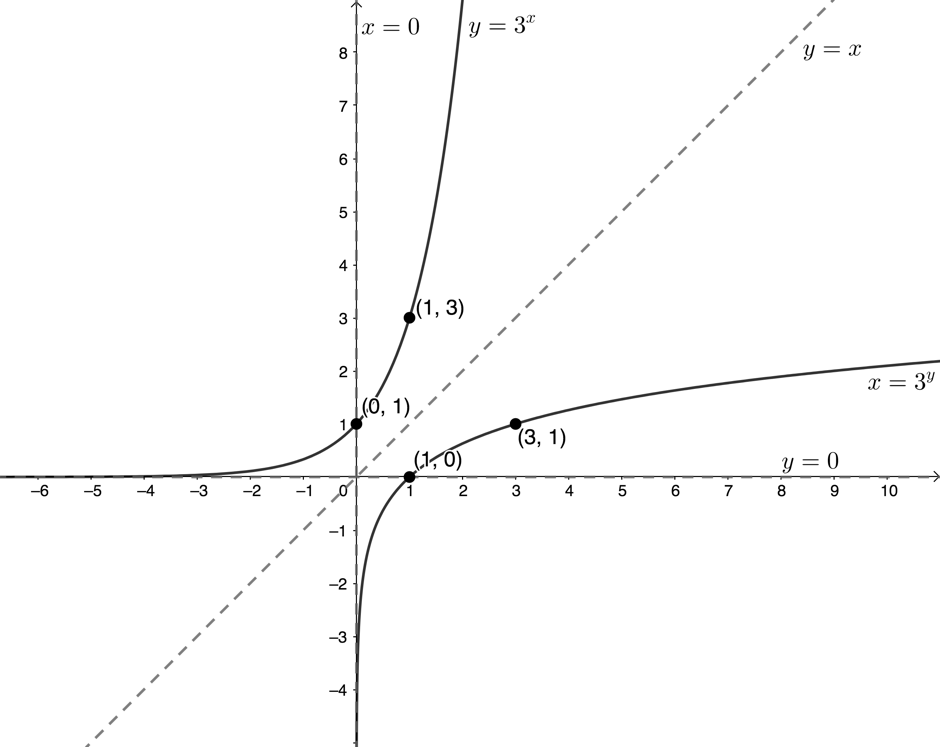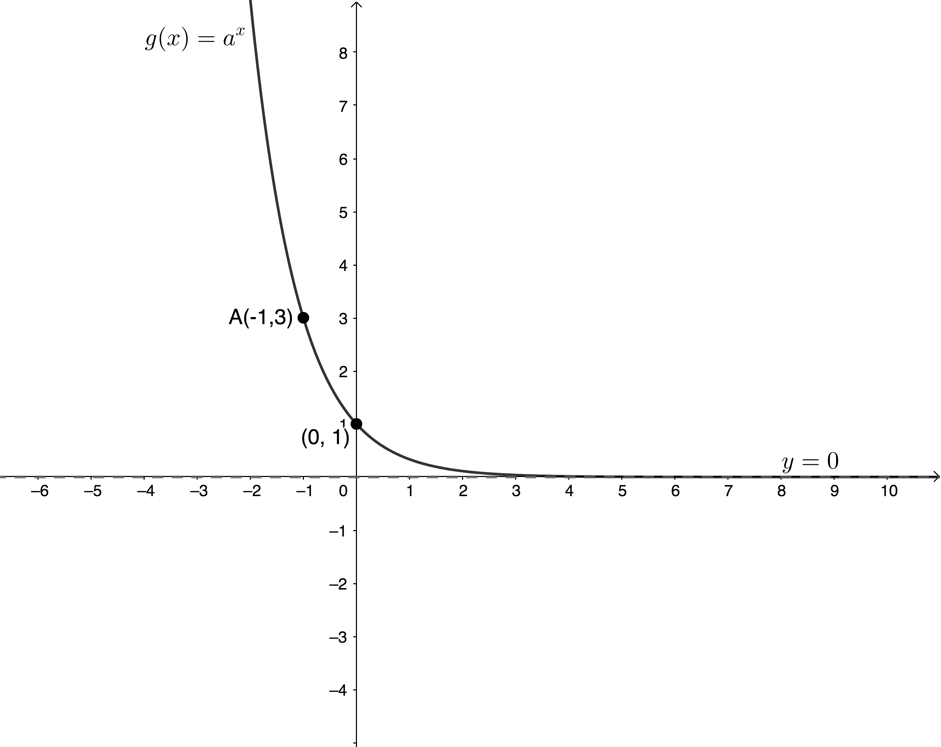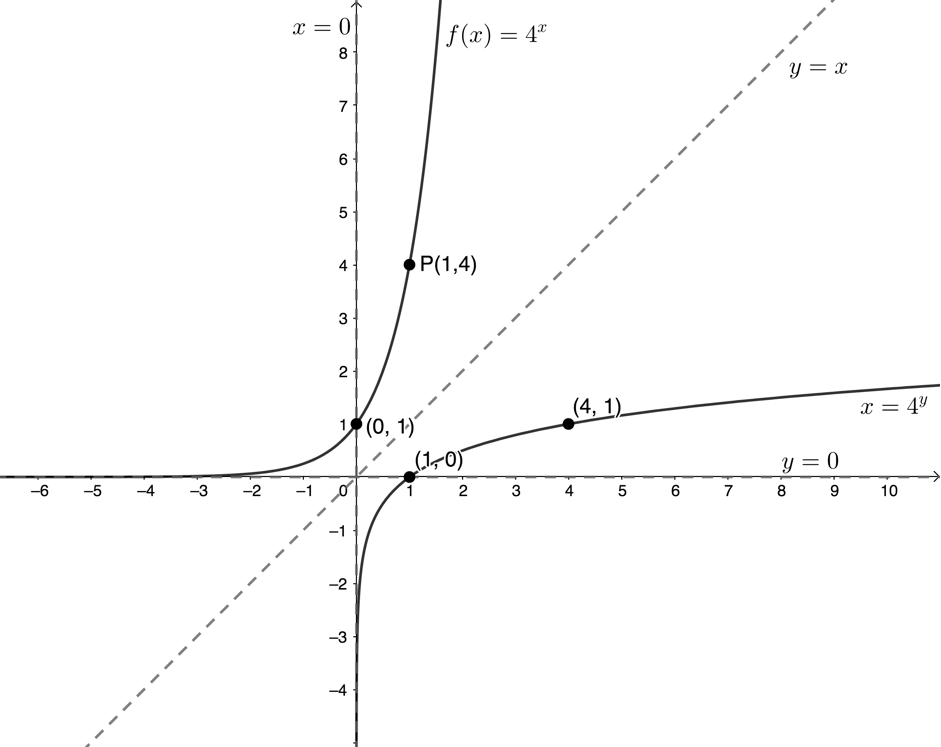Functions and algebra: Use a variety of techniques to sketch and interpret information for graphs of the inverse of a function
Unit 3: Determine and sketch the inverse of the exponential function
Dylan Busa
Unit outcomes
By the end of this unit you will be able to:
- Find the inverse of [latex]\scriptsize y={{a}^{x}}[/latex] where [latex]\scriptsize a \gt 0[/latex].
- Sketch the inverse of [latex]\scriptsize y={{a}^{x}}[/latex] where [latex]\scriptsize a \gt 0[/latex].
- Answer questions about the domain, range, shape, continuity and other characteristics of the inverse graph.
What you should know
Before you start this unit, make sure you can:
- Determine the inverse of a function. Refer to unit 1 if you need help with this.
- Determine if a relation is a function or not using the vertical line test. Refer to unit 1 if you need help with this.
- Determine if a function is invertible or not. Refer to unit 1 if you need help with this.
- Sketch an exponential function. Refer to level 2 Subject outcome 2.1 unit 4 if you need help with this.
Introduction
We saw in unit 1 that linear functions are one-to-one functions and, therefore, are invertible – their inverses are also functions. We saw in unit 2 that if we restrict the domain of quadratic functions of the form [latex]\scriptsize y=a{{x}^{2}}[/latex] to be either [latex]\scriptsize x\le 0[/latex] or [latex]\scriptsize x\ge 0[/latex], we can make the quadratic function one-to-one and hence make the inverse a function as well.
However, is the same true for exponential functions of the form [latex]\scriptsize y={{a}^{x}},a \gt 0[/latex]? Are these exponential functions invertible? If not, is there a way for us to make the inverse of an exponential function of the form [latex]\scriptsize y={{a}^{x}},a \gt 0[/latex] a function?
These are the questions we will answer in this unit.
The inverse of the exponential function
Let’s explore the inverse of exponential functions of the form [latex]\scriptsize y={{a}^{x}},a \gt 0[/latex].
Activity 3.1: The inverse of an exponential function
Time required: 30 minutes
What you need:
- a blank piece of paper or graph paper
- a pen or pencil
- a ruler
What to do:
Start by drawing a Cartesian plane on your piece of paper. Use a scale of about [latex]\scriptsize 1\ \text{cm}[/latex] per unit.
- Plot the function [latex]\scriptsize f(x)={{2}^{x}}[/latex]. If you need to, you can create a table of values and use a point-by-point plot with at least five points.
- Now, determine the inverse of [latex]\scriptsize f[/latex] in the form ‘[latex]\scriptsize x=[/latex]’.
- Plot the inverse of [latex]\scriptsize f[/latex] on your Cartesian plane. It is suggested you create a table of values and plot point-by-point with at least five points.
- Does the inverse of [latex]\scriptsize f[/latex] have an asymptote? If so, what is it and how does it relate to the asymptote of [latex]\scriptsize f[/latex]?
- Is the inverse of [latex]\scriptsize f[/latex] a function? Use the vertical line test to make sure.
- What are the domain and range of [latex]\scriptsize f[/latex] and of the inverse of [latex]\scriptsize f[/latex]?
- About what line are the graphs of [latex]\scriptsize f[/latex] and the inverse of [latex]\scriptsize f[/latex] symmetrical?
- Is the function [latex]\scriptsize f[/latex] increasing or decreasing?
- Is the inverse of [latex]\scriptsize f[/latex] increasing or decreasing?
What did you find?
- Here is a table of suitable values.
[latex]\scriptsize x[/latex] [latex]\scriptsize -3[/latex] [latex]\scriptsize -2[/latex] [latex]\scriptsize -1[/latex] [latex]\scriptsize 0[/latex] [latex]\scriptsize 1[/latex] [latex]\scriptsize 2[/latex] [latex]\scriptsize 3[/latex] [latex]\scriptsize f(x)={{2}^{x}}[/latex] [latex]\scriptsize \displaystyle \frac{1}{8}[/latex] [latex]\scriptsize \displaystyle \frac{1}{4}[/latex] [latex]\scriptsize \displaystyle \frac{1}{2}[/latex] [latex]\scriptsize 1[/latex] [latex]\scriptsize 2[/latex] [latex]\scriptsize 4[/latex] [latex]\scriptsize 8[/latex] 
Remember that the exponential function has a horizontal asymptote, in this case the line [latex]\scriptsize y=0[/latex]. - [latex]\scriptsize y={{2}^{x}}[/latex]
Inverse:
[latex]\scriptsize x={{2}^{y}}[/latex]. We can leave the inverse with [latex]\scriptsize x[/latex] as the subject of the formula. We have no way of rearranging this equation to make [latex]\scriptsize y[/latex] the subject of the equation. - Here is a table of suitable values. In this case, because [latex]\scriptsize x[/latex] is still the subject of the equation, it is easier to choose and substitute in different values for [latex]\scriptsize y[/latex].
[latex]\scriptsize x[/latex] [latex]\scriptsize \displaystyle \frac{1}{8}[/latex] [latex]\scriptsize \displaystyle \frac{1}{4}[/latex] [latex]\scriptsize \displaystyle \frac{1}{2}[/latex] [latex]\scriptsize 1[/latex] [latex]\scriptsize 2[/latex] [latex]\scriptsize 4[/latex] [latex]\scriptsize 8[/latex] [latex]\scriptsize y\text{ if }x={{2}^{y}}[/latex] [latex]\scriptsize -3[/latex] [latex]\scriptsize -2[/latex] [latex]\scriptsize -1[/latex] [latex]\scriptsize 0[/latex] [latex]\scriptsize 1[/latex] [latex]\scriptsize 2[/latex] [latex]\scriptsize 3[/latex] - The inverse of [latex]\scriptsize f[/latex] does have an asymptote of [latex]\scriptsize x=0[/latex]. The asymptote of the original function [latex]\scriptsize f[/latex] is [latex]\scriptsize y=0[/latex]. Therefore, the asymptotes are symmetrical about the line [latex]\scriptsize y=x[/latex].
- The inverse of [latex]\scriptsize f[/latex] is a function. It cuts the vertical line only once.

- Domain of [latex]\scriptsize f[/latex]: [latex]\scriptsize \{x|x\in \mathbb{R}\}\text{ }[/latex]
Range of [latex]\scriptsize f[/latex]: [latex]\scriptsize \{y|y\in \mathbb{R},y \gt 0\}\text{ }[/latex] – remember that the line [latex]\scriptsize y=0[/latex] is a horizontal asymptote. The function approaches this value but never reaches it. Therefore, the range cannot include zero.
Domain of inverse of [latex]\scriptsize f[/latex]: [latex]\scriptsize \{x|x\in \mathbb{R},x \gt 0\}\text{ }[/latex] – the range of the function is the domain of the inverse.
Range of inverse of [latex]\scriptsize f[/latex]: [latex]\scriptsize \{y|y\in \mathbb{R}\}\text{ }[/latex] – the domain of the function is the range of the inverse. - The graphs of [latex]\scriptsize f[/latex] and the inverse of [latex]\scriptsize f[/latex] are symmetrical about the line [latex]\scriptsize y=x[/latex]. This is the same line of symmetry for all inverses we have studied.
- The function [latex]\scriptsize f[/latex] is increasing. This means that as [latex]\scriptsize x[/latex] increases the function increases.
- The inverse of [latex]\scriptsize f[/latex] is also increasing. Once again, as [latex]\scriptsize x[/latex] increases, the function value increases.
In Activity 3.1 we saw that the inverse of the exponential function [latex]\scriptsize y={{a}^{x}}[/latex] is also a function. Therefore, the exponential function is invertible.
Like the inverses of the linear and quadratic functions, the inverse of the exponential function is symmetrical to the original function about the line [latex]\scriptsize y=x[/latex]. This symmetry extends to the intercepts with the axes and the asymptotes.
The y-intercept of the function becomes the x-intercept of the inverse. Where the exponential function of the form [latex]\scriptsize y={{a}^{x}},a \gt 0[/latex] has a horizontal asymptote of [latex]\scriptsize y=0[/latex], its inverse has a vertical asymptote of [latex]\scriptsize x=0[/latex].
Also, the domain of the original function becomes the range of the inverse function and the range of the original function becomes the domain of the inverse function. This is also the same as the inverses for the linear and quadratic functions.
However, we were not able to write the equation for the inverse of the exponential function in the normal ‘[latex]\scriptsize y=[/latex]’ form. We had to leave it with [latex]\scriptsize x[/latex] as the subject.
Did you know?
There is a way to rewrite the inverse of an exponential function, [latex]\scriptsize x={{a}^{y}}[/latex] as ‘[latex]\scriptsize y=[/latex]’. To do so, mathematicians defined the logarithm (or log). It is defined as follows:
If [latex]\scriptsize x={{a}^{y}}[/latex], then [latex]\scriptsize y={{\log }_{a}}x[/latex].
This means that [latex]\scriptsize x={{a}^{y}}[/latex] and [latex]\scriptsize y={{\log }_{a}}x[/latex] are both expressions for the inverse of the function [latex]\scriptsize y={{a}^{x}}[/latex]. Logarithms are not part of the NC(V) curriculum.
In Activity 3.1, we dealt with [latex]\scriptsize f(x)={{2}^{x}}[/latex] and we saw that the function and its inverse were increasing. In other words, as [latex]\scriptsize x[/latex] increases, the function value increases. This is always the case for [latex]\scriptsize a \gt 1[/latex] (see Figure 1).

However, we know that if [latex]\scriptsize 0 \lt a \lt 1[/latex] then the exponential function is decreasing. As [latex]\scriptsize x[/latex] increases, the function value decreases. The inverse of the exponential function where [latex]\scriptsize 0 \lt a \lt 1[/latex] is also decreasing (see Figure 2).

Example 3.1
Given [latex]\scriptsize f(x)={{3}^{x}}[/latex]:
- Is [latex]\scriptsize f[/latex] an increasing or decreasing function?
- State the domain and range of [latex]\scriptsize f[/latex].
- Determine [latex]\scriptsize {{f}^{{-1}}}[/latex], leaving the equation as ‘[latex]\scriptsize x=[/latex]’.
- Is [latex]\scriptsize {{f}^{{-1}}}[/latex] an increasing or decreasing function?
- State the domain and range of [latex]\scriptsize {{f}^{{-1}}}[/latex].
- Draw sketches of [latex]\scriptsize f[/latex] and [latex]\scriptsize {{f}^{{-1}}}[/latex] on the same system of axes and mark the intercepts with the axes, at least one other point on the graph, and the asymptotes.
Solutions
- [latex]\scriptsize a \gt 1[/latex]. Therefore, [latex]\scriptsize f[/latex] is an increasing function.
- Domain of [latex]\scriptsize f[/latex]: [latex]\scriptsize \{x|x\in \mathbb{R}\}\text{ }[/latex]
Range of [latex]\scriptsize f[/latex]: [latex]\scriptsize \{y|y\in \mathbb{R},y \gt 0\}\text{ }[/latex] - [latex]\scriptsize y={{3}^{x}}[/latex]
Inverse:
[latex]\scriptsize x={{3}^{y}}[/latex] - [latex]\scriptsize a \gt 1[/latex]. Therefore, [latex]\scriptsize {{f}^{{-1}}}[/latex]is an increasing function.
- Domain of [latex]\scriptsize {{f}^{{-1}}}[/latex]: [latex]\scriptsize \{x|x\in \mathbb{R},x \gt 0\}\text{ }[/latex]
Range of [latex]\scriptsize {{f}^{{-1}}}[/latex]: [latex]\scriptsize \{y|y\in \mathbb{R}\}\text{ }[/latex] - .

Exercise 3.1
- Given [latex]\scriptsize f(x)={{\left( {\displaystyle \frac{1}{2}} \right)}^{x}}[/latex]:
- Is [latex]\scriptsize f[/latex] an increasing or decreasing function?
- State the domain and range of [latex]\scriptsize f[/latex].
- Determine [latex]\scriptsize {{f}^{{-1}}}[/latex], leaving the equation as ‘[latex]\scriptsize x=[/latex]’.
- Is [latex]\scriptsize {{f}^{{-1}}}[/latex] an increasing or decreasing function?
- State the domain and range of [latex]\scriptsize {{f}^{{-1}}}[/latex].
- Draw sketches of [latex]\scriptsize f[/latex] and [latex]\scriptsize {{f}^{{-1}}}[/latex] on the same system of axes and mark the intercepts with the axes, at least one other point on the graph, and the asymptotes.
- The graph below shows an exponential function of the form [latex]\scriptsize g(x)={{a}^{x}},a \gt 0[/latex]. It passes through [latex]\scriptsize A(-1,3)[/latex].

- Determine the equation of the function [latex]\scriptsize g(x)[/latex].
- Determine the equation of the inverse of [latex]\scriptsize g[/latex].
- Is the inverse of [latex]\scriptsize g[/latex] a function?
- Give the coordinates of the point [latex]\scriptsize B[/latex] on the inverse of [latex]\scriptsize g[/latex] and symmetrical to [latex]\scriptsize A[/latex].
- Is the inverse of [latex]\scriptsize g[/latex] increasing or decreasing?
The full solutions are at the end of the unit.
Summary
In this unit you have learnt the following:
- The exponential function of the form [latex]\scriptsize y={{a}^{x}},a \lt 0[/latex] is invertible – its inverse is also a function.
- When [latex]\scriptsize a \gt 1[/latex], the exponential function and its inverse are increasing – the function value increases as [latex]\scriptsize x[/latex] increases.
- When [latex]\scriptsize 0 \lt a \lt 1[/latex], the exponential function and its inverse are decreasing – the function value decreases as [latex]\scriptsize x[/latex] increases.
- The function [latex]\scriptsize y={{a}^{x}},a \lt 0[/latex] and its inverse are symmetrical about the line [latex]\scriptsize y=x[/latex].
- The y-intercept of the function [latex]\scriptsize y={{a}^{x}},a \lt 0[/latex] becomes the x-intercept of the inverse.
- The function [latex]\scriptsize y={{a}^{x}},a \lt 0[/latex] has a horizontal asymptote of [latex]\scriptsize y=0[/latex] and its inverse has a vertical asymptote of [latex]\scriptsize x=0[/latex].
Unit 3: Assessment
Suggested time to complete: 15 minutes
Question adapted from NC(V) Mathematics Level 4 Paper 1 November 2016 question 2.3
Given: [latex]\scriptsize f(x)={{4}^{x}}[/latex]
- [latex]\scriptsize P(a,4)[/latex] is a point on [latex]\scriptsize f[/latex]. Determine the value of [latex]\scriptsize a[/latex].
- Make a neat sketch graph of [latex]\scriptsize f[/latex], showing clearly the point [latex]\scriptsize P[/latex] and other key features.
- Write down the range of the function [latex]\scriptsize f[/latex].
- Write down the equation(s) of any asymptote(s) of [latex]\scriptsize f[/latex].
- Determine [latex]\scriptsize {{f}^{{-1}}}[/latex] and write your answer in the form ‘[latex]\scriptsize x=[/latex]’.
- Using your graph in 2, write down the coordinates of two points that lie on [latex]\scriptsize {{f}^{{-1}}}[/latex].
- On the same set of axes as the graph of [latex]\scriptsize f[/latex], sketch the graph of [latex]\scriptsize {{f}^{{-1}}}[/latex].
- Is [latex]\scriptsize {{f}^{{-1}}}[/latex] a function or non-function? Give a reason for your answer.
- The graphs of [latex]\scriptsize f[/latex] and [latex]\scriptsize {{f}^{{-1}}}[/latex]are symmetrical about a line. Write down the equation of this line.
The full solutions are at the end of the unit.
Unit 3: Solutions
Exercise 3.1
- .
- [latex]\scriptsize 0 \lt a \lt 1[/latex]. Therefore, [latex]\scriptsize f[/latex] is a decreasing function.
- Domain of [latex]\scriptsize f[/latex]: [latex]\scriptsize \{x|x\in \mathbb{R}\}\text{ }[/latex]
Range of [latex]\scriptsize f[/latex]: [latex]\scriptsize \{y|y\in \mathbb{R},y \gt 0\}\text{ }[/latex] - [latex]\scriptsize y={{\left( {\displaystyle \frac{1}{2}} \right)}^{x}}[/latex]
Inverse:
[latex]\scriptsize x={{\left( {\displaystyle \frac{1}{2}} \right)}^{y}}[/latex] - [latex]\scriptsize 0 \lt a \lt 1[/latex]. Therefore, [latex]\scriptsize {{f}^{{-1}}}[/latex] is a decreasing function.
- Domain of [latex]\scriptsize {{f}^{{-1}}}[/latex]: [latex]\scriptsize \{x|x\in \mathbb{R},x \gt 0\}\text{ }[/latex]
Range of [latex]\scriptsize {{f}^{{-1}}}[/latex]: [latex]\scriptsize \{y|y\in \mathbb{R}\}\text{ }[/latex] - .

- .
- [latex]\scriptsize g(x)={{a}^{x}}[/latex] and passes through [latex]\scriptsize A(-1,3)[/latex]. Therefore:
[latex]\scriptsize \begin{align*}g(-1) & =3\\\therefore {{a}^{{-1}}} & =3\\\therefore \displaystyle \frac{1}{a} & =3\\\therefore a & =\displaystyle \frac{1}{3}\end{align*}[/latex]
[latex]\scriptsize g(x)={{\left( {\displaystyle \frac{1}{3}} \right)}^{x}}[/latex] - [latex]\scriptsize y={{\left( {\displaystyle \frac{1}{3}} \right)}^{x}}[/latex]
Inverse:
[latex]\scriptsize x={{\left( {\displaystyle \frac{1}{3}} \right)}^{y}}[/latex] - The inverse of [latex]\scriptsize g[/latex] is a function.
- [latex]\scriptsize B[/latex] is symmetrical to [latex]\scriptsize A[/latex] about [latex]\scriptsize y=x[/latex]. Therefore [latex]\scriptsize B(3,-1)[/latex].
- The inverse of [latex]\scriptsize g[/latex] is a decreasing function since [latex]\scriptsize 0 \lt a \lt 1[/latex].
- [latex]\scriptsize g(x)={{a}^{x}}[/latex] and passes through [latex]\scriptsize A(-1,3)[/latex]. Therefore:
Unit 3: Assessment
- .
[latex]\scriptsize \begin{align*}f(x) & ={{4}^{x}}=4\\\therefore x & =1\end{align*}[/latex]
[latex]\scriptsize a=1[/latex] - .

- Range of [latex]\scriptsize f[/latex]: [latex]\scriptsize \{y|y \gt 0\}[/latex]
- Horizontal asymptote of [latex]\scriptsize f[/latex] is [latex]\scriptsize y=0[/latex].
- [latex]\scriptsize y={{4}^{x}}[/latex]
Inverse:
[latex]\scriptsize x={{4}^{y}}[/latex] - [latex]\scriptsize (1,0)[/latex] and [latex]\scriptsize (4,1)[/latex]
- .

- [latex]\scriptsize {{f}^{{-1}}}[/latex] is a function. Each input produces one and only one output.
- [latex]\scriptsize y=x[/latex]
Media Attributions
- activity3.1 A1 © Geogebra is licensed under a CC BY-SA (Attribution ShareAlike) license
- activity3.1 A3 © Geogebra is licensed under a CC BY-SA (Attribution ShareAlike) license
- activity3.1 A5 © Geogebra is licensed under a CC BY-SA (Attribution ShareAlike) license
- figure1 © Geogebra is licensed under a CC BY-SA (Attribution ShareAlike) license
- figure2 © Geogebra is licensed under a CC BY-SA (Attribution ShareAlike) license
- example3.1 © Geogebra is licensed under a CC BY-SA (Attribution ShareAlike) license
- exercise3.1 Q2 © Geogebra is licensed under a CC BY-SA (Attribution ShareAlike) license
- exercise3.1 A1f © Geogebra is licensed under a CC BY-SA (Attribution ShareAlike) license
- assessment A2 © Geogebra is licensed under a CC BY-SA (Attribution ShareAlike) license
- assessment A7 © Geogebra is licensed under a CC BY-SA (Attribution ShareAlike) license

